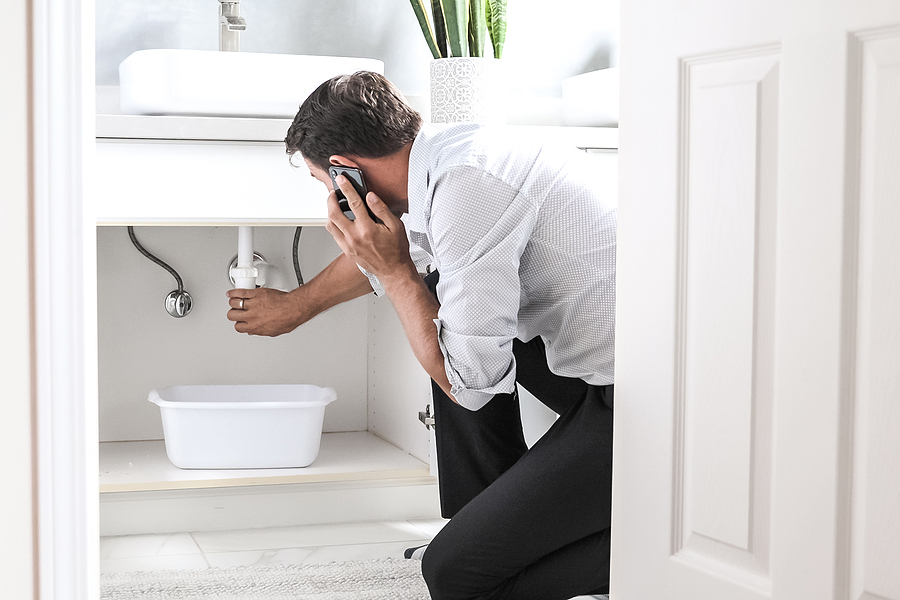Leaks come in all shapes and sizes from an inconsequential drip every few minutes from a pinhole in the pipe to the sort of spectacular burst that brings to mind the classic Three Stooges film entitled “A Plumbing We Will Go”. It goes without saying, but I’m going to say it anyhow, that you do not respond in the way that Curly and Moe do by frantically adding new pipes and ultimately connecting the water to the electricity supply.
Or indeed Larry, who spends the entire episode digging up the yard in a fruitless attempt to find the shut-off valve. But at least Larry has the right idea. The first thing to do if you have a bad leak anywhere in your plumbing system is to turn off the water.
Isolate the leak
Sometimes you can be lucky (relatively speaking) and find yourself able to isolate a leak from your cistern by simply turning off the tap that leads to it. It’s generally behind the toilet and plumbers call it a mini stop. But for most leaking pipes and taps you will need to turn off the water at the mains. The tap on your water meter is the one that shuts off water to your whole plumbing system. It helps to then open a few taps to empty out any remaining water.
Pinhole patch
What you do next depends on the nature and location of the leak. If it’s just a pinhole leak you can get by for a while by simply wrapping duct tape around it. However, duct tape is only going to hold for just so long. You could lengthen the time it lasts by using a lining of plumber’s tape or even use some epoxy putty, but a hole is a hole and you will find that any patch will ultimately fail.
Staunch the flow
That said, buying some time while you find a good plumber at the right price is worth it. For more serious leaks, you also need to minimise the damage it can do to your home. You can for instance clamp a piece of rubber and wood over the leak with a C- clamp. The piece of rubber needs to be sufficiently pliant to form a seal to staunch the flow.
Snug fit
Another option is to use a sleeve clamp that fits snugly around the pipe. There are two problems with this. The most obvious one is that you are not likely to be in possession of the right sized sleeve clamp unless you are a plumber. The second potential problem is that the leaking pipe may well be secured to the wall and not be amenable to being surrounded by a bulky clamp.
Cut it out
The only long lasting solution is to remove the offending section of pipe and replace it. If it’s a copper pipe that means having the welding equipment and skills to weld the new piece into place. However, you can insert a copper coupling as a temporary fix. Although again this requires you to have some specialised tools. You can’t just hack out a piece with a hacksaw because the end of the pipe needs to fit the coupling neatly. The tools that you would need to have to do this effectively are a pipe or tube cutter and a deburrer. Pipe cutters keep your cut nice and straight and deburrers do what they say – take the burrs off the end of the pipe.
PVC pipes
PVC pipes are a little more forgiving and you can get away with just using a hacksaw to cut out the leaking piece. The coupling is fitted and tightened to form a seal and voilà! The leak is gone. Clearly you can’t weld PVC without disastrous results, but, as it is considerably cheaper than copper, the permanent fix sees whole lengths of PVC replaced along with the joining pieces.
Everywhere a sign
Generally, a leak is pretty obvious. There’s water squirting out of the pipe where it shouldn’t be. But leaking pipes can be insidious. You need to know the signs to look out for if you are to avoid water damage to your house or spend more than you need to on you water bill.
Self-watering garden
The water bill itself is a sign. If your water bill goes up dramatically for no good reason, you might have a burst or leaking pipe hidden away somewhere in your walls or floor. One type of leak that goes under the radar and first appears as a spike in your water charges is when an old galvanised pipe finally rusts through underground and starts watering the garden on a 24/7 basis. During a wet winter this can go unnoticed for a while, especially if it’s in a neglected corner. In other seasons a dramatic burst of growth can point to the source of such a leak. Fixing galvanised pipes in this situation involves some serious digging. Unless you’re especially keen, I would leave this one to the plumber.
Stains and bubbles
Other indications of water damage are discoloured stains on your ceilings or walls. Paint or wallpaper bubbling on the wall means moisture is getting behind it somehow. The burst pipe is most often where the signs of water damage are, but occasionally the water can trickle and then pool in a different spot. Corrosion on and around your pipes as well as mould and rotten wood associated with pipes can all be signs of a leaking pipe.
Don’t Panic
A leaking pipe is not a disaster, no matter how alarming it might look. By doing a few inexpensive things, you can give yourself the time to deal with it properly or have a professional plumber provide a permanent fix. A well placed clamp can let you get on with things until it’s convenient to resolve the problem. So when you do spot a leak, don’t panic. Get on with fixing it up.


